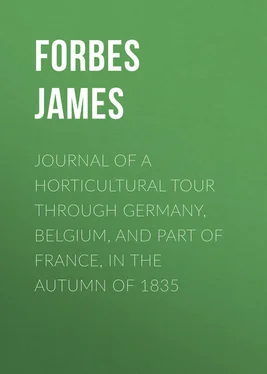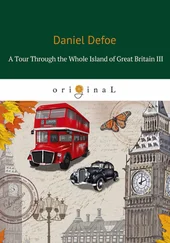James Forbes - Journal of a Horticultural Tour through Germany, Belgium, and part of France, in the Autumn of 1835
Здесь есть возможность читать онлайн «James Forbes - Journal of a Horticultural Tour through Germany, Belgium, and part of France, in the Autumn of 1835» — ознакомительный отрывок электронной книги совершенно бесплатно, а после прочтения отрывка купить полную версию. В некоторых случаях можно слушать аудио, скачать через торрент в формате fb2 и присутствует краткое содержание. Жанр: foreign_home, Сад и огород, foreign_antique, foreign_prose, на английском языке. Описание произведения, (предисловие) а так же отзывы посетителей доступны на портале библиотеки ЛибКат.
- Название:Journal of a Horticultural Tour through Germany, Belgium, and part of France, in the Autumn of 1835
- Автор:
- Жанр:
- Год:неизвестен
- ISBN:нет данных
- Рейтинг книги:3 / 5. Голосов: 1
-
Избранное:Добавить в избранное
- Отзывы:
-
Ваша оценка:
- 60
- 1
- 2
- 3
- 4
- 5
Journal of a Horticultural Tour through Germany, Belgium, and part of France, in the Autumn of 1835: краткое содержание, описание и аннотация
Предлагаем к чтению аннотацию, описание, краткое содержание или предисловие (зависит от того, что написал сам автор книги «Journal of a Horticultural Tour through Germany, Belgium, and part of France, in the Autumn of 1835»). Если вы не нашли необходимую информацию о книге — напишите в комментариях, мы постараемся отыскать её.
Journal of a Horticultural Tour through Germany, Belgium, and part of France, in the Autumn of 1835 — читать онлайн ознакомительный отрывок
Ниже представлен текст книги, разбитый по страницам. Система сохранения места последней прочитанной страницы, позволяет с удобством читать онлайн бесплатно книгу «Journal of a Horticultural Tour through Germany, Belgium, and part of France, in the Autumn of 1835», без необходимости каждый раз заново искать на чём Вы остановились. Поставьте закладку, и сможете в любой момент перейти на страницу, на которой закончили чтение.
Интервал:
Закладка:
I could not but admire the neatness in which the plants and grounds in this extensive establishment were kept, and notwithstanding the extreme dryness of the weather, (not having had any rain for nine weeks in that part of the country,) the plants were looking all in a healthy and flourishing state; but the watering of such a collection for so many weeks must have been attended with an enormous expence.
August 23rd. Being accompanied by Mr. Booth, we proceeded along the banks of the Elbe to the villa of M. de la Camp, which is situated close by the road, commanding a most beautiful view of the Elbe and its shipping, as well as Finkenwarder, an island on the opposite side of the Elbe, the one half of which belongs to Hanover, and the other half to Hamburgh. This island produces a very hardy species of oak, which was found there some years ago, and is called the Quercus Falkenbergense . M. de la Camp has formed a very complete vineyard on the banks of the Elbe, which was in a very prolific state, as were also the vines that formed an arbour to the front of this gentleman's house.
From this we next proceeded some miles further along the Elbe banks, to the seat of Mr. Baur at Blankanese. This gentleman is a wealthy merchant, and has expended an immense sum of money in the formation of his grounds, according to the English system of gardening. He has formed numerous walks and artificial banks, that command extensive views of the Elbe. These walks and banks, were staked out by Mr. Baur personally, who, I have no hesitation in saying, has displayed a very superior taste; they are remarkably well executed: in short, the banks and valleys appeared as if they had been formed by nature, but they are principally the work of art. I however regretted not to find a corresponding taste for good plants, to keep pace with the other extensive ground improvements that this gentleman has completed and is proceeding with.
Close by the Elbe are situated several small forcing houses for fruits, a greenhouse, orangery, and some low pits for the cultivation of the pine-apple, which has been grown here for several years; but they do not seem yet to have made much progress in the cultivation of this fruit. In front of these houses there is a terrace-wall, that separates the garden-ground from the Elbe, which washes up against it. The stones with which this wall was built were brought a distance of from four to five hundred miles (from Saxony) for this purpose; and it is executed in a very superior manner. On the highest part of the grounds there has been lately erected a handsome Chinese pagoda, which commands a beautiful prospect of the Elbe and its shipping, as well as the opposite island and Hanoverian dominions. A round tower also been lately built, which forms a pretty object in these grounds; several other objects of interest are also to be seen dispersed in various parts, which are considered superior to any other gardens in the neighbourhood of Hamburgh, and are consequently much frequented every Sunday by visitors, as on that day it is open to the public. We were obliged to take our departure from them much sooner than I could have wished, owing to a very heavy shower of rain which continued for a considerable time; and it being the only rain of any consequence that had fallen in the course of nine weeks, it was very agreeable to that part of the country. Mr. Baur has recently built in these grounds a very handsome house, according to the English style of building, but it is not yet inhabited. It was impossible not to admire the very superior and substantial manner in which the works are all executed in this gentleman's establishment.
On my return from this place to Flottbeck, I then proceeded back to Hamburgh: when on my way I was much surprised to observe bricklayers in some places busy at work, although Sunday. Towards the evening, the rain had quite abated; I then made the best of my way for the Botanic Gardens, which are situated in the suburbs of the town, on a part of the ground which, during the reign of Buonaparte, formed a strong fortification, but these have recently been demolished: they are now laid out as a public promenade for the inhabitants of the town, and likewise a Botanical establishment for the cultivation of plants, and from its beautiful situation, it is certainly one of the best chosen sites for this purpose that has come under my observation. It appeared to be of considerable extent, and irregular form, sloping in part of it, down to the old rampart ditch, which now forms a handsome piece of water, bounding the garden, and separating it from the promenade on the opposite side, which being laid out as a pleasure ground, with clumps of trees and shrubs on the grass, when viewed from the Botanic Garden, gives a stranger the idea that it is a part of the Botanical establishment, giving the latter a much more extensive appearance than it actually possesses. The extent of hothouses for the growth of exotic and Cape plants, is rather limited, and did not seem to be more than about two hundred and fifty feet in length. I here observed some very fine specimens of Cacteæ , and likewise several rare species of Palms , such as the Zamia , Frideriis , Guilielmi , Ætensteinii , Lehmanii , Caffra , and Horrida . I also was much delighted by seeing in flower, a very pretty plant, called the Olendorfia procumbens , which I believe has not yet made its appearance in England. A great portion of the ground in this establishment is occupied by trees and shrubs, which are cultivated for sale, for the support of the garden, consequently much ground is taken up by these, which ought to be assigned to single specimens. In the herbaceous ground, there is also an extensive collection of hardy perennial plants.
August 24th. Went at five o'clock in the morning, to see the fruit and vegetable market, which seemed to be well supplied with fruit and culinary vegetables. I observed large quantities of the new Orleans plum, summer Bergamot pear, and the black cherries, which appeared to be larger than the same sort (Hertford blacks,) grown in this country. The Haricot bean , is also in great repute in Germany, and certainly deserves to be more extensively cultivated in this country, than it hitherto has been, as it forms an excellent substitute for the French bean or the scarlet runner , which is cultivated here in preference.
Читать дальшеИнтервал:
Закладка:
Похожие книги на «Journal of a Horticultural Tour through Germany, Belgium, and part of France, in the Autumn of 1835»
Представляем Вашему вниманию похожие книги на «Journal of a Horticultural Tour through Germany, Belgium, and part of France, in the Autumn of 1835» списком для выбора. Мы отобрали схожую по названию и смыслу литературу в надежде предоставить читателям больше вариантов отыскать новые, интересные, ещё непрочитанные произведения.
Обсуждение, отзывы о книге «Journal of a Horticultural Tour through Germany, Belgium, and part of France, in the Autumn of 1835» и просто собственные мнения читателей. Оставьте ваши комментарии, напишите, что Вы думаете о произведении, его смысле или главных героях. Укажите что конкретно понравилось, а что нет, и почему Вы так считаете.












